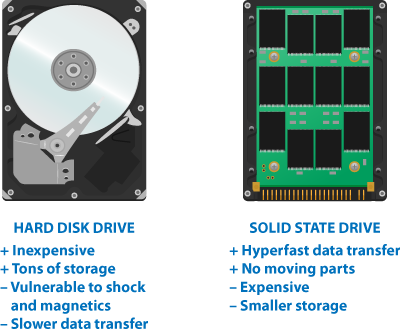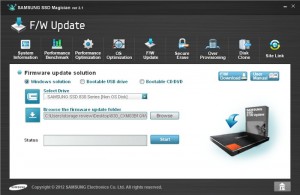-
-
products
-
resources
-
support
-
company
-
How to Replace a Hard Drive with SSD on your PC
By Steve Horton May 11, 2012hard drive, HDD, SDD, solid state driveNo CommentsIllustration: Gordon McAlpin So you’d like to go the Solid State Drive (SSD) route. Maybe you’ve heard that these types of drives are much faster than hard drives and are ideal for Windows and applications, while hard drives are good for movies and other large files.
The guide below explains how to replace a hard drive with SSD on your PC:
Step 1: Back up your data
When moving from a HDD to an SSD, you will probably be going from a large drive to a smaller drive and will need to back up some of your data to an external source. This guide offers detail about the best backup methods. You will either need to clone your drive, Windows and all, or reinstall Windows on the new drive and move documents over selectively.
- A clone or image
- You can also clone or image your old drive and restore the image to the new drive. (You’ll need another drive to store this large image in the interim.) This has the advantage of keeping all your settings for programs with digital rights management, such as Windows itself. Nobody wants to have to put their code in again. To do this, though, the used space on your old drive must be less than or equal to the size of the new drive. I recommend moving all your large media files, such as movies, to another location to get the size down before cloning. Most of the drive-based solutions at the link above, including the built-in Windows Backup and Restore, support creating an image of your old drive.
- A backup followed by a new Windows installation
The third option here is to back up specific files to a new location, then do a brand new install of Windows on the SSD and move files over selectively from the backup. Clean Windows installs have fewer errors, and a brand new drive likes it when there are fewer errors. This has the disadvantage of requiring you to re-enter installation codes for many applications.Step 2: Remove the hard drive and install the solid state drive
This will usually be as simple as opening the PC and swapping drives and keeping the same cables, being sure to unplug the PC from power first. Sometimes your new drive will be a different form factor than the old drive (meaning it’s too small for the space), and you’ll need a separate caddy or enclosure in that case.
Note that if there is more than one open drive bay in your desktop, there’s no reason not to install the solid state drive alongside of, rather than in place of, your hard drive. In this case,
Step 3: Restore from backup
Whatever backup method you chose, after installing the new drive is a good time to restore from that backup, if only to have Windows back on the drive so you can do other things. You may have to format the drive (erase its contents) before you can restore; Windows will take you through this step automatically.
An example of a firmware update application for a solid state drive. Step 4: Update the firmware on your solid state drive
The firmware is the code on your hard drive itself that helps it work with your PC correctly. Newer firmware keeps the drive free of errors, helps it work with newer hardware, and keeps the speed and reliability higher.
Google the model number of your drive for specific instructions; this usually involves running a utility from within Windows. Remember to leave the PC running the entire time the firmware is updating to avoid damaging your PC.
Note: Remember not to defragment solid state drives, as these drives do so automatically, and running a defragment on them will provide no benefit.
Another note: Be sure and enable TRIM if you’re using a solid state drive with Windows 7. It’s for advanced users, but it helps maintain and improve performance on your drive. Here’s a guide for doing so.
Enjoy the speed and reliability benefits of your SSD. It’s one of the highest speed to cost ratios of any upgrade you could perform.
Was this post helpful?YesNoFree Driver Updates
Update your drivers in less than 2 minutes to enjoy better PC performance - Free.
Free Driver Updates
Update your drivers in less than 2 minutes to enjoy better
PC performance - Free.
Didn't find your answer?Ask a question to our community of experts from around the world and receive an answer in no time at all.most relevant recent articles Pin It on Pinterest


